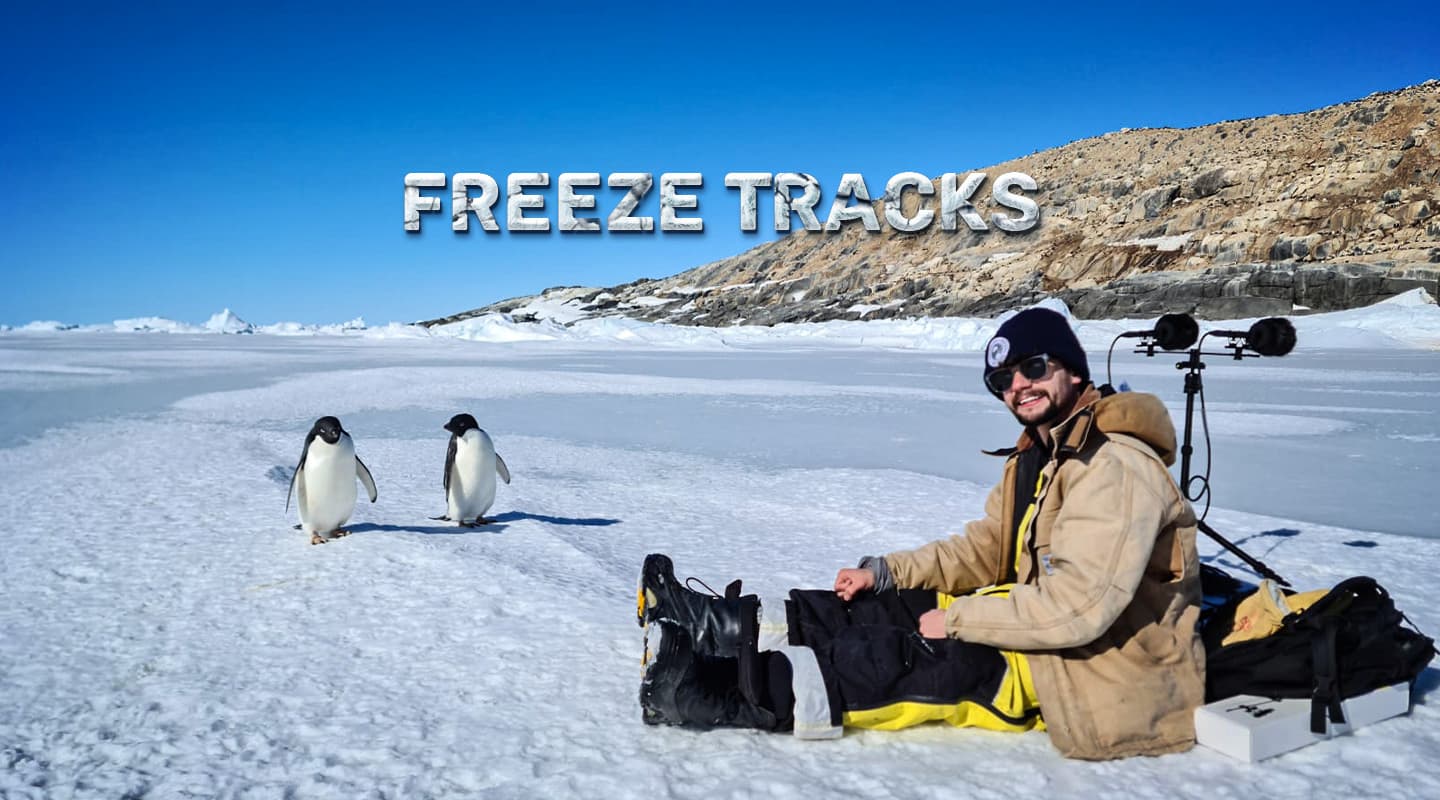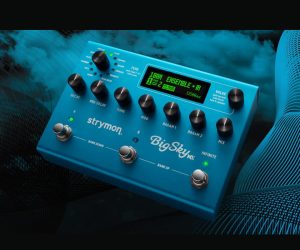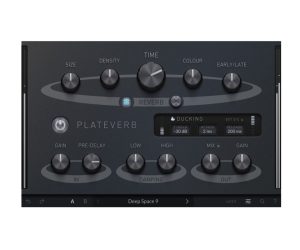
Freeze Tracks
How a location recordist spends a summer in Antarctica.
Being chased by a belching elephant seal in sub-zero temperatures probably isn’t what Andrew Leeder had in mind when he first developed a love for location recording. It’s crazy where a passion for sound can take you, and the lengths one goes to to capture a rare sound.
Fortunately Antarctic elephant seals only move a few metres at a time before taking a breather, so Andy lived to tell this particular tale, which is just one of many unforgettable experiences during a months-long stint in Antarctica.
Andy’s journey with audio began with mixing, mastering and music composition. After studying a Bachelor of Sound Production at SAE Institute in Brisbane, he began working as a broadcast technician at BAI Communications where he cut his teeth as a skilled communications electronics technician.
“My main job was repairing electronics and making sure TV and radio stations stayed on the air,” Andy explains. “I got in through my skills in repairing microphones and channels strips.”
But as time went on, his passions followed a clear path to location recording and sound design.
“I love all the different aspects of music and audio, but what I get from location recording, especially out in nature, is this sense of peace. I can be there, do my job, and if I’m happy with what I’m capturing, this wonderful moment comes over me where everything is okay. You get some blissful and peaceful moments.”
Coupled with that is Andy’s passion for travel. “Ever since I left high school I’ve been a big traveller. I love that I can say that now. I was in India recently recording soundscapes in the desert for about a week. Again, such a wonderful peace comes over me when I am out recording natural sounds.”


HEADING SOUTH
It was a golden opportunity. The Australian Antarctic Division posted a job listing for a Communications Technical Officer to work on radio and satellite communications on the Davis base over the course of a summer season. Andy applied, and his skills and experience in electronics won him the role. But he was most excited about his plans off-the-clock during his Antarctic stay, using the opportunity to capture the fascinating, peculiar, and largely unrecorded sounds of the frozen continent at the bottom of the globe.
And the goal? To build a comprehensive Antarctica sound library.
“If you Google ‘Antarctic sound library’, you don’t get much. I think there is a lack of really special sounds from Antarctica because it’s such a difficult place to get to. I want to help people be creative with some of these really special animals and sounds that you’re just not going to get anywhere else. So now I have 40GB of wonderful recordings that I’m currently processing to publish in a sound library.”
I caught up with Andy to learn more about his Antarctic adventures.
LIFE ON STATION
AT: What type of work did your Communications Technical Officer role in Antarctica involve?
AL: I was at a location called the Vestfold Hills on Davis Station. Everything we do there is to support science and research in Antarctica. There are frequent field trips out to do measurements of lakes, penguin counting, maintenance trips to field huts, things like that. All of these parties require radios, backup radios and safety communication systems to make sure everyone is okay, and we have check-in protocols in place so that the station leader and everyone on station know the people out in the field are safe.
On top of this there’s a satellite system on station for communications back to Australia. That carries all of our communications, the Internet, anything external to the stations goes through this satellite system. That needs to be maintained as a matter of importance because if you lost that all you have is voice communication via HF radios, which is much less reliable. Both of these systems are maintained by the station communications technical officer.
I want to help people be creative with some of these really special animals and sounds that you’re just not going to get anywhere else

AT: So you did all your location recording in between shifts?
AL: Yes, I would go out almost every day, every chance that I could because I didn’t want to miss anything. Things are constantly changing with the seasons there so there’s something different everyday.
I’d sneak out either super early in the morning or as soon as work finished and go on a five-hour mission to record the elephant seals again, or the emperor penguins, and it’s usually about a 12km round trip. I’m out there with my 20kg survival pack plus audio gear walking through the rocky Vestfold Hills covered in snow and ice. They’re also covered in these things called dikes which are dried lava systems that look like black highways running through the rock. It’s this landscape of brown rock covered in giant black lava roads that you’re walking through with ice and snow. Eventually you start hearing the belches of the elephant seals – they are so loud, you’re not going to miss them. They weigh up to 3600kg. I’d find a great place to set up and record them for hours before heading back to station.
What’s difficult is it’s so cold. The wind will pick up, my fingers are freezing, my face is all red and covered in snow, but as I’m going back there’s always little things that make me want to stop and unpack all my gear and set up again. I’d pass some skua birds circling overhead – they’re scavengers, and they’ll fly directly over your head just checking if you’re alive. Getting their cries is rare as well. Or I’d walk past some baby storm petrels and set the gear up to record their cries. They’re hidden amongst the rocks and you’ll never lay eyes on them because they’re hiding from the skuas. So it was this constant battle of going back to station and getting warm again, or staying out another hour and recording these beautiful creatures.



SOUND DECISIONS
Antartica’s summer climate of -15° to 5°C makes very specific demands of audio equipment. Batteries don’t last as long, small amounts of moisture quickly turn to ice, vibrations travel through ice for kilometres, and high speed winds can obstruct clean recordings.
These are struggles Andy knows all too well. With no retail stores nearby, every item of audio gear he took on the trip was selected carefully.
AT: What’s in the bag when you go out recording?
AL: Because I’m travelling long distances in the cold with 20kg+ on my back with three or four layers of clothes, I don’t want to carry too much. So I have a single Manfrotto stand which is very compact and light, about 1kg. It has studs on the bottom so it sits in the snow without moving and I can mount a pair of mics on a stereo bar on it. I carry two Aquarian H2d hydrophones for underwater recording, two DPA 4006 omni condenser mics, two DPA 4060s, a Zoom H8 with a backup SD card, two mic leads for my stereo setup, and a Zoom H5 backup recorder which I never had to use. I also have wind protection for the mics.
AT: Why did you pick the Zoom H8 as your field recorder?
AL: I was particular about which recording device I used. I talked with the guys at Dynamic Music and there was a shortage of F3 and F6 recorders at the time. What was available to me was the H8 – they were saying it’s been taken to Everest and were quite sure it would work out well. They got it to me at really short notice which was wonderful. It’s just super rugged – it survived Antarctica, it’s survived the desert in India. I’m very impressed with how it handles the conditions, the wind, the snow, the ice, the cold. Even wearing gloves all the time it’s responsive.
The H8 has six XLR inputs. I would use four max. I have some really nice recordings where I have submerged a pair of hydrophones off the edge of some sea ice – I walk over to the edge carefully and pop the hydrophones a few metres apart and a few metres down – and then I’ve also set up a pair of DPA 4006s. That lets me capture what’s happening below the ice and above the ice at the same time. I was able to get penguins coming out of the water, landing on the ice, and making some noises – you can hear things like their footsteps above and below.
AT: Tell me about your microphone choices.
AL: I didn’t want to go cheap on microphones and find the diaphragm starts to ice up or the electronics inside aren’t insulated well enough to stop the circuit board from cracking. The DPA 4006s are wonderful for soundscapes and I know they’ve been taken to Mars before so they’re going to do okay in Antarctica.
The Aquarian H2D hydrophones have a small capsule. They’re not super high end but they’re very rugged and that’s what I went for going into Antarctica. The Weddell seals make some absolutely crazy sounds underwater, it sounds like Star Wars down there. It’s like a sine wave sweep from 20kHz down to 100Hz and it’ll go for 30 seconds, they make these laser sounds, it’s insane.
The sea ice melts through the Antarctic summer and it’s about 1.5m thick in the location where I was. I was capturing the sound of it melting. I’d use this huge drill that’s about 2m long to drill down into the sea ice and pop the hydrophones in. You can hear lots of little cracks and every now and then these epic loud ones as the temperature of the sea water changes enough for the ice to crack.
The H8 was great for two main reasons. Obviously I was very impressed with its durability, but secondly, it’s a handy recorder. I had the standard Zoom XYH-6 mic capsule in my pocket as I was walking about to grab sounds I didn’t have time to set up for. If the H8 wasn’t a handy recorder I wouldn’t have captured the skua calls or some of these really special moments that I needed to be prepared for.
it was this constant battle of going back to station and getting warm again, or staying out another hour and recording these beautiful creatures



POINT & SHOOT
AT: What’s your typical microphone configuration?
I record everything in stereo with my mics in omni set up in A/B configuration. I sometimes changed the capsules on the DPAs to adjust the EQ curve depending on what I was recording. Using omni means I can eliminate proximity effect and it’s brilliant for soundscapes.
There are very few places in the world where you can go and find zero unwanted noise – there’s always going to be some kind of human activity. Even in some deserts you’ll still hear noises of cattle or goats or a plane overhead – it’s super difficult to find a location like Antarctica where there is pretty much zero unwanted noise. That’s why the omni mics worked so well, because I didn’t mind where the sound sources were coming from, they’re all magic.
AT: That means the only noise-making factor is you?
AL: Yes, I’ll usually just be sitting there silently with a smile. But it was a challenge because if it’s especially cold or windy I’m wearing my wind protection, and anything that’s windproof is the noisiest thing on the planet. So I’d either sit there super silently or I’d go for a walk while the gear was recording.
AT: Do you use headphones for monitoring?
AL: Maybe 50% of the time. The reason I didn’t bring them sometimes is just because of their weight and because they’re fragile. Initially I would plug in some headphones to check the stereo field, check the distance from the sound source, maybe the height of the mics, but it’s something I did less as I got to know my equipment more.
AT: What was your most memorable moment?
AL: Probably the most surprising and fun moment was when I once left all the gear out recording while I went to have dinner on station. I came back about an hour later and there was a couple of penguins wandering about my gear – these Adelie penguins are really curious. As I was getting closer I could see the hydrophone leads had been shifted and one of the hydrophones had been pulled out of the water – I’d left it two metres deep and it was now three metres on the ice. And I’ve got all this recorded above the water and below. When the penguins are moving the mics the hydrophones are full of noise but you can tell there’s a little group of them and they’re just yelling at each other and having fun.

ANTARCTIC SOUND LIBRARY
Andy is in the process of cleaning up and collating his hours of Antarctic audio into a specially curated sound library which will be available on his website: www.outthereaudio.com.
“The sound library is going to be almost everything I have recorded. It includes things like Emperor penguins, Adelie penguins, Weddell seals, elephant seals, the birds of Antarctica like skuas and storm petrels. I also got the sounds around the station which are really cool. The satellite dome at the station is made up of something called Tevlar and it’s a bunch of irregular shapes that come together to create a dome that protects the satellite dish from snow and wind. Inside this dome sounds absolutely insane so I took an impulse response from inside the dome. I have lots of soundscapes like the Antarctic wind, the sound of the Antarctic ocean, the beach, the swell, ice cracking, walking on ice, walking on snow – I tried to get everything I could.”

























Great article. What an experience. Thank you.